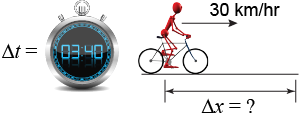|
The velocity equation appears in many physics problems in different ways. For example, you may be asked to - calculate a velocity given displacement or initial and final positions;
- calculate a time given velocity and position or displacement; or
- calculate initial position, final position, or displacement.

|
Consider an object that moves with constant velocity v over a time interval Δt, during which the object changes its position by Δx. The equation for velocity can be rearranged three ways. Each is useful for solving a different variation of problems involving velocity, displacement, and time. The equations are given two ways, in the notation of Δx and Δt, and in the less precise form of d, v, and t. In either case, this is the same relationship expressed, or solved, in different ways. 
|

|
 A bicyclist rides due east for 3 min and 40 s at a velocity of 30 km/hr. How many meters does the cyclist travel?
A bicyclist rides due east for 3 min and 40 s at a velocity of 30 km/hr. How many meters does the cyclist travel? | Asked: | distance Δx in meters | | Given: | v = 30 km/hr; t = 3 min, 40 s | | Relationships: | v = Δx /Δt → Δx = vΔt | | Solution: | Units must be made consistent.
Convert the velocity to m/s and the time to seconds.
| 
|
Many real-world situations express quantities in different units, such as kilometers per hour (km/hr) or minutes. Before applying any equation the units must be consistent or the numerical answer may not be what you expect. This problem asks for the distance in meters. Therefore, it was best to convert all quantities to meters, seconds, or meters per second. 
|
| |
|

